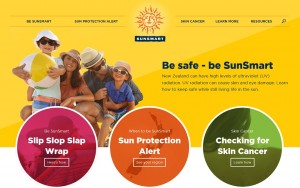Summer is finally here! BBQs, long evenings, sunbathing, swimming and days at the beach are just some of the things we’ve been looking forward to. But as exciting as this time of year can be (especially once school finishes for the year – wahoo!) it is really important that we keep reminding ourselves about keeping safe in the sun, in the water and at the beach.
Exposure to UV (ultraviolet) radiation is what causes our skin to burn and potentially lead to skin cancer, the most common form of cancer in New Zealand. We have to be especially careful here, because the UV levels in our country are higher than other countries around the world, so it is easier to get sunburnt in a short amount of time. Although it is good for us to get out in the sun to build up the vitamin D in our bodies, it is really important that we keep our skin protected.
During daylight savings months (September to April) it is recommended that we wear sunscreen, particularly during the middle of the day (between 10am and 4pm) when the sun is at its hottest. It is a good idea to wear a sunhat at all times outside, and cover up whenever possible. This could mean sitting under an umbrella or a tree, and throwing a t-shirt on over your togs when you’ve finished swimming. The sun can also damage your eyes, so a pair of sunglasses is also a great summer addition. Check out the Sunsmart New Zealand website for more sun safety tips.
Taking a dip is a great way to cool off during the hot Summer months, but sadly a large number of kiwis and people from overseas drown in New Zealand every year. We are lucky to have lots of wonderful places to swim, be it rivers, beaches or swimming pools, but we must always remember to keep ourselves safe from harm while in the water. Learning to swim, using appropriate equipment like life jackets and arm bands, and keeping an eye on others (especially young children) is the first step to preventing drowning.
If we are swimming in a river, we can also check for shallow rocks, floating trees or other debris, and fast flowing currents before jumping in to ensure that it is a safe spot. When swimming at the beach, getting caught in a rip that can pull you out to deeper water is a very scary possibility. Check the water before you get in for discolouration or a rippled look – this could indicate a rip. However, your best bet is to swim between the flags, where trained lifesavers can keep an eye on you, and never go deeper than you feel comfortable. The Water Safety New Zealand website has answers to any other water safety questions you might have.
And don’t forget, if the weather is bad there’s no need to be stuck at home because you can always visit our libraries for some summer fun.


